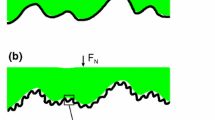Abstract
We study the statistics of equally spaced pairs of receptors on a family of ordered flat microsubstrates whose adhesive centers form regular tessellations. We establish relationship between the symmetry of substrates and the probability density of the end-to-end polymer separation in terms of the so-called Manhattan distance.
Access this chapter
Tax calculation will be finalised at checkout
Purchases are for personal use only
Similar content being viewed by others
References
See, e.g. Intelligent Substrate Inc., Micropatterned substrates: Highlights from the literature. Available: www.intelligentsubstrates.com/Applications/Applications.html
Crosby AJ, Hageman M, Duncan A (2005) Controlling polymer adhesion with ‘Pancakes’. Langmuir 21:11738–11743
Lee I, Zheng H, Rubner MF, Hammond PT (2002) Controlled cluster size in patterned particle arrays via directed adsorption on confined surfaces. Adv Mater 14(8):572–577
Zheng H, Lee I, Rubner MF, Hammond PT (2002) Two component particle arrays on patterned polyelectrolyte multilayer template. Adv Mater 14(8):569–572
Azioune A, Capri N, Tseng Q, Théry M, Piel M (2010) Protein micropatterns: a direct protocol using deep UVs. Methods Cell Biol 97:133–146
Otsuka H (2010) Nanofabrication of nonfouling surfaces for micropatterning of cell and microtissue. Molecules 15:5525–5546. Available: www.mdpi.com/1420-3049/15/8/5525/pdf
Tikhomirov G, Hoogland S, Lee PE, Fisher A, Sargent EH, Kelly SO (2011) DNA-based programming of quantum dot valency, self-assembly and luminescence. Nat Nanotechnol 6:485–490
Lee I, Wool RP (2000) Polymer adhesion vs. substrate receptor group. Macromolecules 33:2680–2687
Rana N, Kossow C, Eisenbraun ET, Greer RE, Koloyeros AE (2011) Controlling interfacial adhesion of self-assembled polypeptide fibrils for novel nanoelectromechanical systems (NEMS) applications. Micromachines 2:1–16. Available: www.mdpi.com/2072-666X/2/1/1/pdf
Raghavan S, Chen ChS (2004) Micropatterned Environments in Cell Biology. Adv Mater 16(15):1303–1313
Amin R, Hwang S, Park SH (2011) Nanobiotechnology: an interaction between nanontechnology and biotechnology. NANO 6(2):101–111
Pannier AK, Anderson BC, Shea LD (2005) Substrate-mediated delivery from self-assembled monolayers: effect of surface ionization, hydrophilicity, and patterning. Acta Biomater 1(5):511–522
Grünbaum B, Shepard G (1986) Tilings and patterns. W. H. Freeman, New York
Janse van Rensburg EJ (2003) Statistical mechanics of directed models of polymer in the square lattice. J Phys A: Math Gen 36(15):R11–R61
Bender CM, Bender MA, Demaine ED, Fekete SP (2004) What is the optimal shape of a city? J Phys A: Math Gen 37(1):147–159
Leung VJ et al (2002) Processor allocation on Cplant: achieving general processor locality using one-dimensional allocation strategies. In: Proceedings of the 4th IEEE international conference on cluster computing. Willey-Computer Society Press, Chicago, pp 296–304
Rakenburg IC, Zieve RJ (2001) Influence of shape on ordering of granular systems in two dimensions. Phys Rev E 63(6):61303
Domański Z (2011) Geometry-induced transport properties of two dimensional networks. In: Schmidt M (ed) Advances in Computer Science and Engineering. InTech, Rijeka, 2011, pp 337–352. Available: www.intechweb.org/books
Domański Z, Sczygiol N (2011) Distribution of the End-to-End Distance of Polymers Trapped onto Ordered Substrates. Lecture Notes in Engineering and Computer Science 2011, WCECS 2011, 19–21 October, 2011, San Francisco, pp 604–608
Domański Z (2011) Efficiency of two-dimensional microfilters. AIP Conf Proc 1373:211–220
Author information
Authors and Affiliations
Corresponding author
Editor information
Editors and Affiliations
Rights and permissions
Copyright information
© 2013 Springer Science+Business Media Dordrecht
About this chapter
Cite this chapter
Domański, Z., Sczygiol, N. (2013). Distribution of the Distance Between Receptors of Ordered Micropatterned Substrates. In: Kim, H., Ao, SI., Rieger, B. (eds) IAENG Transactions on Engineering Technologies. Lecture Notes in Electrical Engineering, vol 170. Springer, Dordrecht. https://doi.org/10.1007/978-94-007-4786-9_24
Download citation
DOI: https://doi.org/10.1007/978-94-007-4786-9_24
Published:
Publisher Name: Springer, Dordrecht
Print ISBN: 978-94-007-4785-2
Online ISBN: 978-94-007-4786-9
eBook Packages: EngineeringEngineering (R0)




